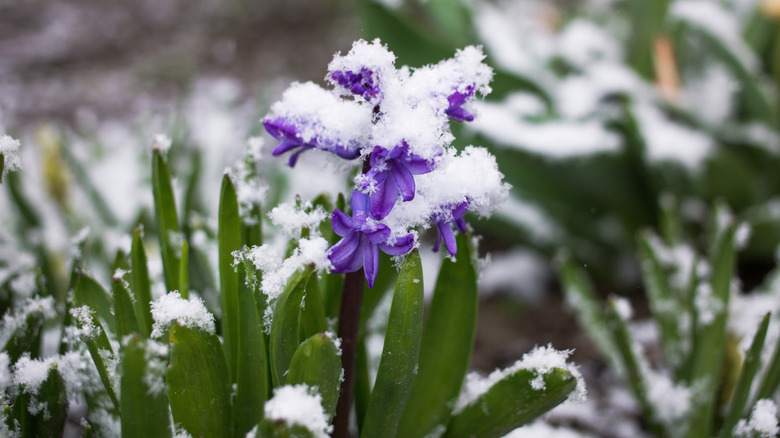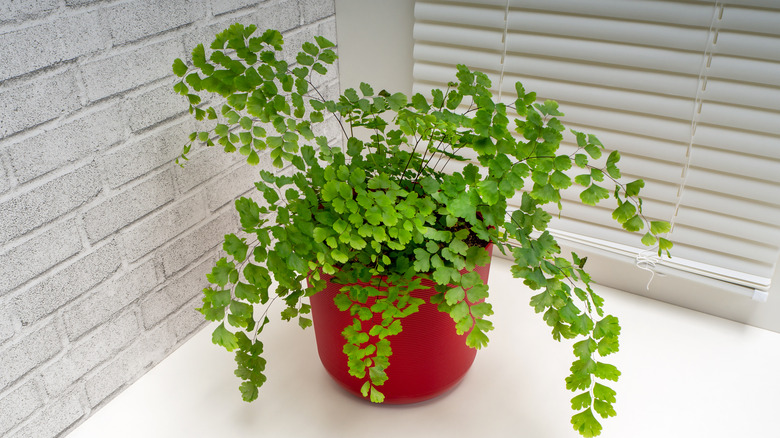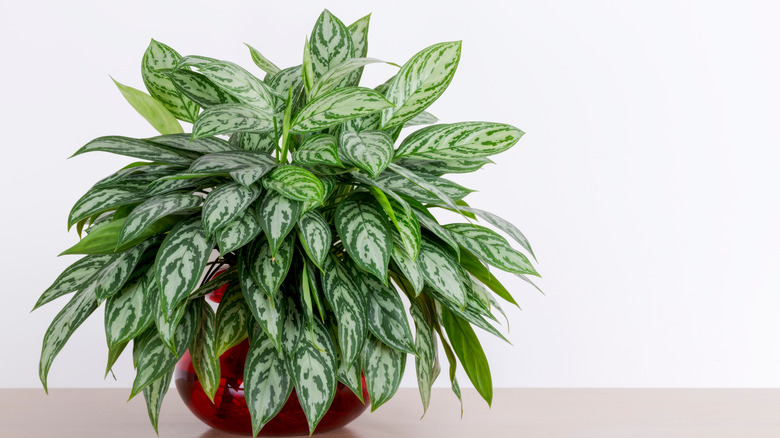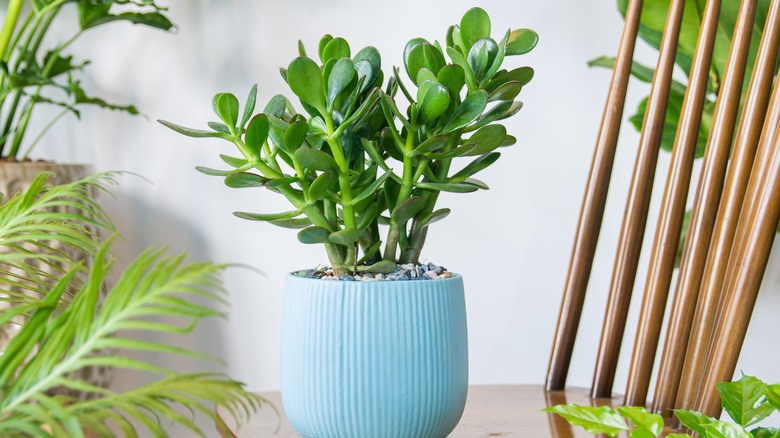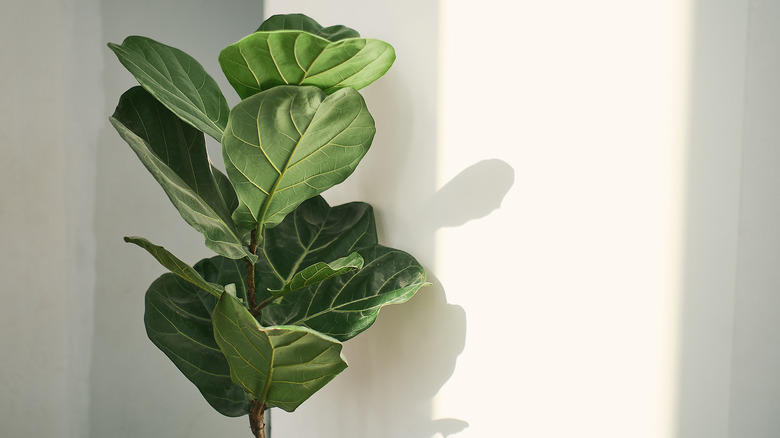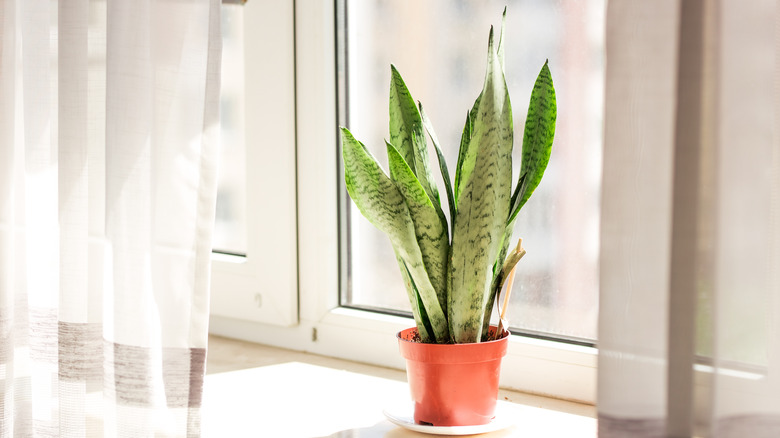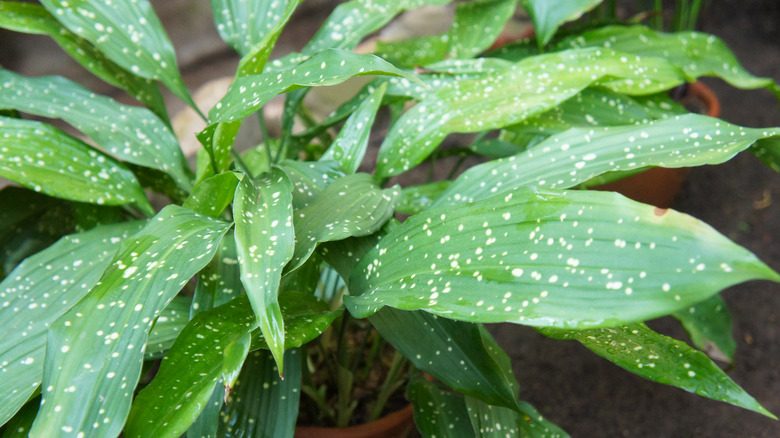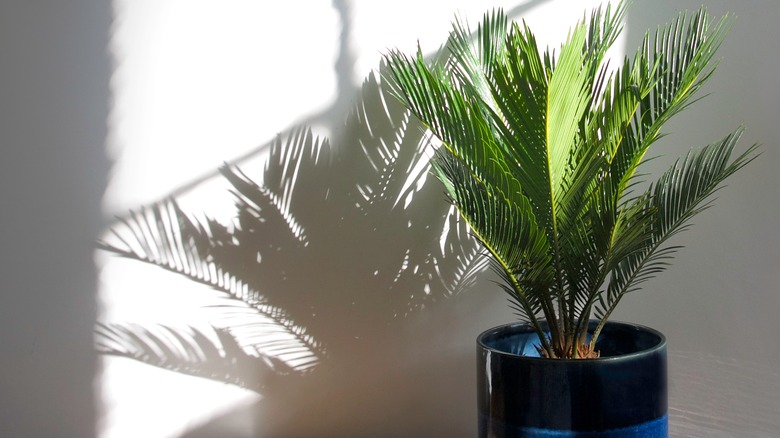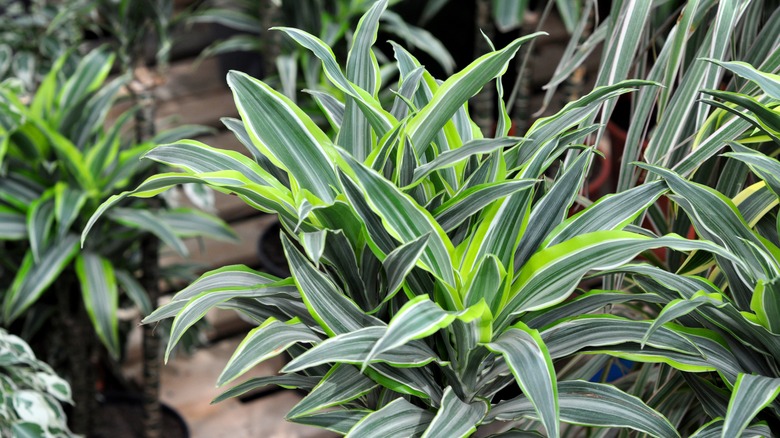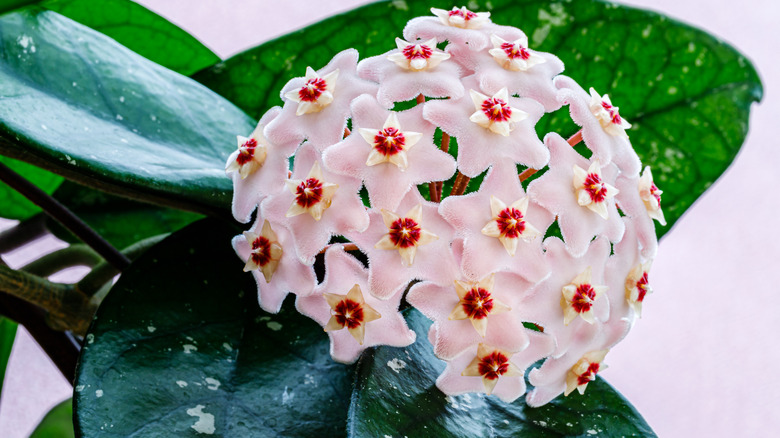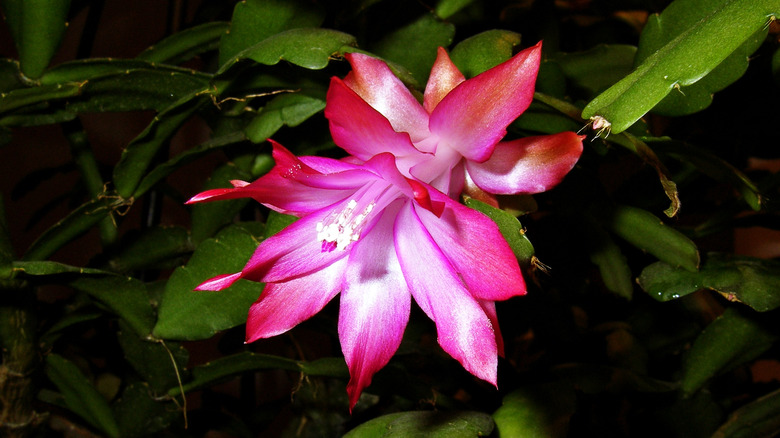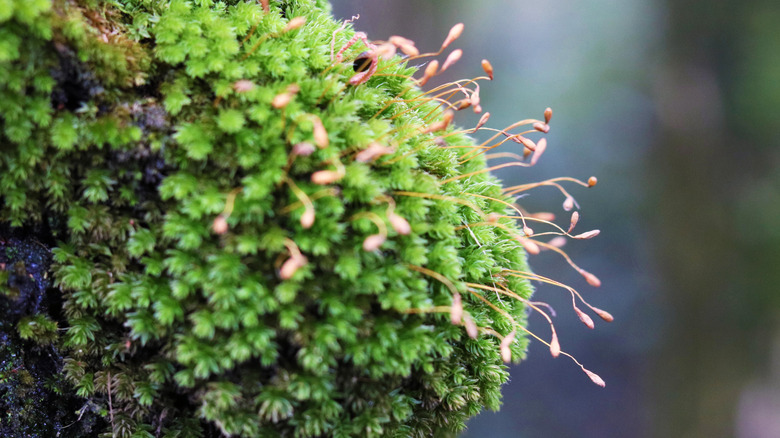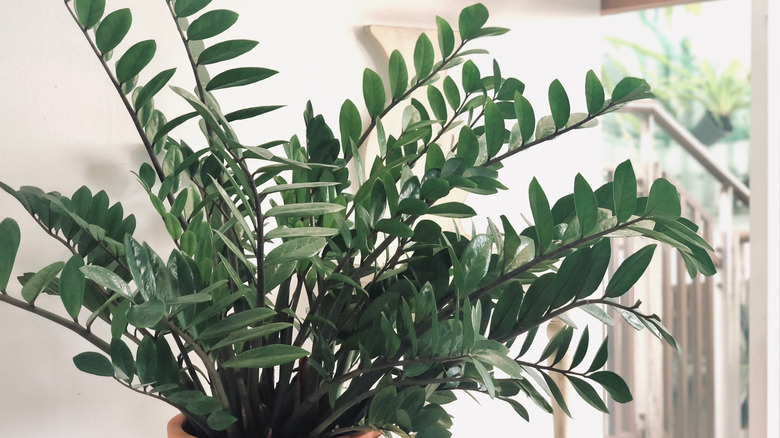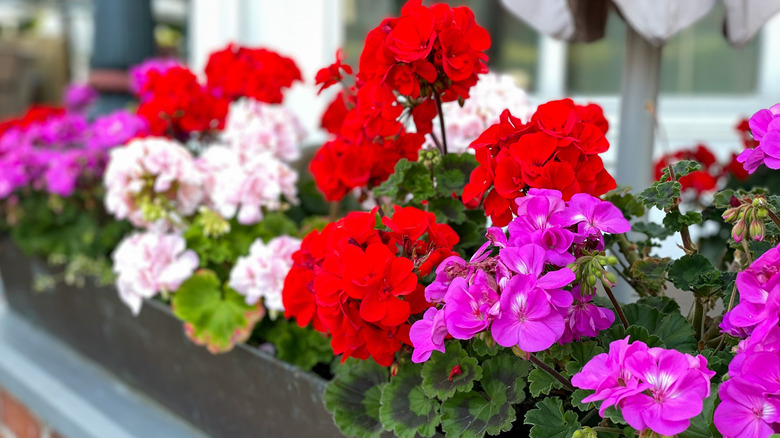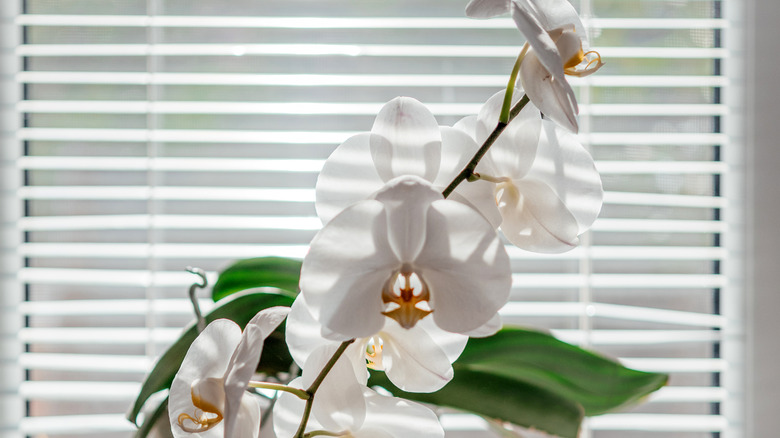The Best Houseplants To Have If You Live In A Cold Climate
Plenty of plants prefer warm climates, but if you live somewhere colder, you can still have great and healthy plants at home. Your houseplants can thrive if you create a more habitable temperature inside your home during the winter. According to Bioadvanced, you can help your greenery survive through the chilly months with a few tips and tricks. The first is to ensure that your plants get the correct amount of sunlight each day — which can be tricky when the days are so short. Depending on the location of your windows, you might have to take a more hands-on approach and move your plants throughout the day to keep them in the sun. If all else fails, use artificial light sources like fluorescent bulbs or grow lights.
Next, think about maintaining the correct humidity for your plants. Most homes typically only have about 5 to 10 percent humidity in winter, while most houseplants prefer things to be more to the tune of 40 to 50 percent. An easy way to get your plants more humidity is to place them on the bathroom counter and run a hot shower. However, this will be easier if you own plants that do better in the cold. So, here are some of the best houseplants to grow if you live in a cold climate.
1. Maidenhair Fern (Adiantum)
According to House Plant Journal, the Maidenhair Fern (Adiantum) is easy to grow and makes an ideal ground cover plant and potted variety. The only thing you should note is that these plants absolutely love moist soil. So much so that these ferns can be a little dramatic if the soil gets too dry. Remember: even if you take impeccable care of maidenhair ferns, sometimes a frond or two will die. This occurrence doesn't necessarily mean that the plant is sick or even that it is dehydrated. Sometimes, fronds just wilt.
The plants do well in direct sunlight. So, if you have them potted inside and leave them by the window all winter, they should do fine. Even if the air in your home starts to feel a little bit dry throughout the winter, your primary concern should really be to keep checking the soil. While these ferns like humidity, plants only really take in water from their roots, so it's essential to monitor the moisture where it really counts. In this case, it's the soil, not really the air.
2. Chinese Evergreen (Aglaonema)
According to Garden Design, the Chinese evergreen plant is a traditional sign of good luck. You can find the plant growing naturally in tropical and subtropical forests of Southeast Asia and even down into New Guinea. Sometimes, the plant is referred to as a Philippine evergreen plant, as it is also indigenous to the Philippines. The ideal temperature for these plants to thrive is about 65 to 80 degrees Fahrenheit.
During the summer, most places in the USA will rise to well above these temps, while winters plunge deeply below. Due to this variation in outside temperatures, Chinese evergreens are ideal houseplants. No matter the weather, most climate-controlled homes fall solidly within this range. In addition, these plants enjoy plenty of humidity. You might get the most enjoyment out of them by placing them in a room with high amounts of moisture, like a kitchen, laundry room, or bathroom. If placed elsewhere in the home, you can purchase a small humidifier if the air gets too dry during the winter.
3. Jade Plant (Crassula Ovata)
Succulents are always pretty easy to care for, no matter the weather. If you live in a colder climate, filling your home with varieties of succulents like a Jade Plant might mean you have an easier time caring for your collection. According to the Old Farmer's Almanac, these plants are visually attractive and easy to take care of, looking like little trees. Jade Plants can also live for generations and generations, making them a unique plant that can almost become part of your family.
Jade Plants do well in warmer, drier conditions. Even if you live in a colder climate, the inside of your home will often be warm and dry due to artificial heating. The key to keeping the plant healthy is to not overwater it to compensate for the dry air. Jade Plants are unfortunately prone to root rot, so you want to ensure that you let the soil dry out completely before watering again. If you ever place your Jade Plant outside, bring it indoors if the forecast is supposed to dip below 50 degrees Fahrenheit.
4. Fiddle Leaf Fig (Ficus Lyrata)
The Fiddle Leaf Fig tends to do well in typical indoor temperatures. The plant is originally from the West African rainforests, like the Guinean Forests and the Eastern Afromontane. If you take care of it properly, this plant can live anywhere from 25 to 50 years, making it a perfect, long-term investment for your home. If you live in a cold climate, the ficus should spend almost 100 percent of its time indoors, with some minor exceptions for the summer months.
However, pay close attention to the evening temperatures to ensure there is no damage to the plant's leaves overnight. A small caveat: it is best to do all this planning well in advance, as moving around the plant too much can cause distress. Seriously, a ficus needs stability to thrive. Once indoors, your fig will love to be in a place near a window so that it can have hours of sunlight exposure. Keep an eye on things to make sure the leaves don't burn.
5. Snake Plant (Dracaena Trifasciata)
The Snake Plant is ideal for beginners because it isn't too fussy about the weather. According to the Old Farmer's Almanac, the plant has a few other names it commonly goes by. The first is Mother in Law's Tongue, while the second is Sansevieria. No matter the name you use, the plant is a succulent, meaning it's an easygoing, hearty plant. Native to southern Africa, the plant likes lots of space and sends out runners in all directions to expand. Because of this, it can grow out of control if not monitored, so only grow it in a pot unless you want it to take over everything.
Like most plants, freezing temperatures and frost can hurt the leaves of the Snake Plant. If it's going to be less than 50 degrees Fahrenheit outside, move the plant indoors to keep warm. However, it should be fine in anything warmer. Snake plants do well in shade and bright sun, but be careful about moving the plant from a shady corner to the center of your patio, as a sudden change can be too much for the plant to thrive.
6. Cast-Iron Plant (Aspidistra Elatior)
According to MasterClass, cast-iron plants don't even need direct sunlight to do well, which makes them ideal for people who live somewhere with short, cold days during the winter. In fact, many people call these plants Bar Room Plants because of their lack of need for light. Direct sunlight can cause damage to the leaves, like bleaching. If a leaf or two does die, prune it to make room for the newer leaves that will soon grow behind it.
These glossy green plants typically prefer temperatures between 60 and 75 degrees Fahrenheit and will wilt or even die below 50 degrees. However, it's easy to maintain this ideal temperature range if you keep them inside. In addition to not needing too much light, you only have to water a cast-iron plant about once a week. They really are a set and forget about it sort of plant.
7. Sago Palm (Cycas Revoluta)
According to Costa Farms, Sago palm plants have been around since the dinosaurs and can weather pretty much anything. However, if you live somewhere a little bit colder most of the year, you might need a few extra tips to keep yours thriving. The first tip is that these plants do best in medium or bright light but not direct light. Even if you think it might like the sun, keep it in a bright room instead of right next to the window because too much direct sunlight can scorch the fronds.
Since it's a pretty drought tolerant plant, you can water it about once a week, and it should be just fine. Even so, remember to check the soil to ensure it's had the opportunity to dry out before you add more water. You don't want the root system to rot. A final thing to remember is that the Sago palm plant can be very poisonous to pets and small children if ingested. To avoid an accident, keep it out of reach.
8. Dracaena
According to Planterina, plants in the Dracaena family do well in weather above 65 degrees Fahrenheit, making them ideal for indoor growing. There are more than 120 species in both tree and shrub varieties, so you really have plenty of options. The plants can grow quite large, so experts recommend that you remove the top of the plant to regulate growth. However, the best part is the bit you remove can easily be used to propagate more plants. It's kind of like an infinite growth hack.
Sometimes the plant might need a little more humidity than it's getting. This tip can be especially true in winter when your heating sources may cause the air in your house to be warm and dry. You will tell that your plant needs damper air because its leaves will start getting brown and brittle. If this happens, you can use a humidifier to revive it or even place it in the bathroom while you take a steamy shower.
9. Hoya
Hoya plants don't typically like the cold. However, if living in a cold climate means you prefer to keep the heater nice and toasty, they can do well year round no matter where you live. According to Molly's Tropical Plants, the key to success is maintaining the warm, humid conditions that Hoya plants enjoy when the weather outside gets a little chilly. If you live in a climate-controlled house, or even better, have a greenhouse, this should not be too difficult.
There are a few small things you can do on top of controlling the temperature of your house to maintain the success of your Hoya plant. The first is to ensure the plant isn't near any exterior doors. This way, your Hoya isn't constantly subjected to cold blasts of air anytime you open the door. In addition, you don't want your Hoyas to freeze or even get frosty. While keeping the plant near the window for sunlight is important, be sure it is not touching the window. Consider keeping the plant even further back if you have single pane windows. Single pane windows lack substantial insulation, which can be damaging to plants.
10. Christmas Cactus (Schlumbergera Bridgesii)
As its name might suggest, this plant can do well in colder weather. According to Chicago Botanic Garden, the Christmas cactus is very different from most of its cousins that live in the arid desert. This plant is native to the tropical rainforest, so it tends to be very thirsty. You will need to water it once the top inch of soil in its pot begins to feel dry, which might happen more regularly than you think. Be sure to check it often to avoid any issues.
The plant is thermo-photoperiodic, so whether or not the cactus blooms depends on a specific set of factors. First, if the temperature is between 55 and 70 degrees Fahrenheit, it needs about 13 hours of pitch black darkness to do its thing. However, if it's warmer (about 70 degrees), it will take about 15 hours to bloom. Pitch black means just like how it sounds. Most owners prefer to cover the plant with a sheet and place it in a closet to achieve this dark environment.
11. Moss (Bryophyta)
On its own, moss needs warmer weather, but inside a terrarium, it does well in all kinds of weather. If you live in a cold climate, consider adding a terrarium to your houseplant collection. According to the Terrarium Planting Guide, moss doesn't have a typical root system. Instead, it has rhizoids, sometimes called root hairs. This network of hairs clings to other items like rocks, bricks, and even other plants. The moss then absorbs water from all over instead of just through the rhizoids. There are over 20,000 different kinds of moss, and all of them behave similarly.
Moss does take a while to grow, and each growth can last for many years. It doesn't require too much maintenance, other than some watering. It's the perfect houseplant for cold climates because of this. You can usually purchase moss from your local garden center or home maintenance store. However, you can also collect moss from your yard or a neighborhood park to introduce into your terrarium.
12. ZZ Plant (Zamioculcas Zamiifolia)
Since this plant originated in areas of Africa prone to drought, it can tolerate a lot of gaps in care and strange temperatures. According to Gardenista, the plant became popular worldwide in 1996 when Dutch nurseries in South Africa began exporting it. The plant typically grows about two to three feet tall and has dark green leaves that photograph well.
Like most houseplants, it needs sunlight and watering about once a week. However, because of its drought history, you can go a little bit longer in between without causing too many problems. It's important to note that the ZZ plant is toxic if ingested, so keep it away from curious kids or pets. In addition, there have also been some reports of the plant irritating the skin on your hands. You don't necessarily need gloves to handle the plant, but you should definitely wash your hands after touching the leaves.
13. Geraniums (Pelargonium)
These pretty flowering plants do best in temperatures 60 degrees and above. According to Gilmour, planting geraniums is very easy, and you reap plenty of rewards because of their pleasant fragrance. The plant first grew in South Africa. They then went to France and were brought to the Americas in 1786. They are popular due to their beautiful leaves and vibrant flowers.
Geraniums can grow seasonally in most parts of the USA and even year-round in warmer climates. In colder climates, however, they work best as a houseplant if you want to enjoy them for longer. In fact, the cooler night temperatures of the spring and fall encourage them to bud. It's best to monitor the weather carefully and your home's internal temperature. There are over 300 species of geraniums that come in a variety of sizes. Some are as small as six inches across, while others are up to several feet.
14. Moth Orchid (Phalaenopsis)
Native to Southeast Asia and Australia, there are over 50 different species of this easy-to-care-for plant, according to House Plants Expert. Moth orchids grow colored blooms all year round and are easy to grow, as they do well in the heat and direct sun. However, if you live somewhere that tends to be a bit colder, do not worry. They can grow vibrant flowers that last up to three months. If the flower turns brown or wilts, prune it immediately to give the plant more energy to produce the next batch of blooms.
For the best results, temperatures of 65 to 85 degrees Fahrenheit during the day and 60 to 65 at night are ideal. Even in the coldest climates, these temperatures should be easy to maintain indoors. However, these plants prefer lots of light, sometimes up to ten hours a day. If the winters in your area have abbreviated hours of sunshine, you might have to supplement natural light with a sun lamp.
